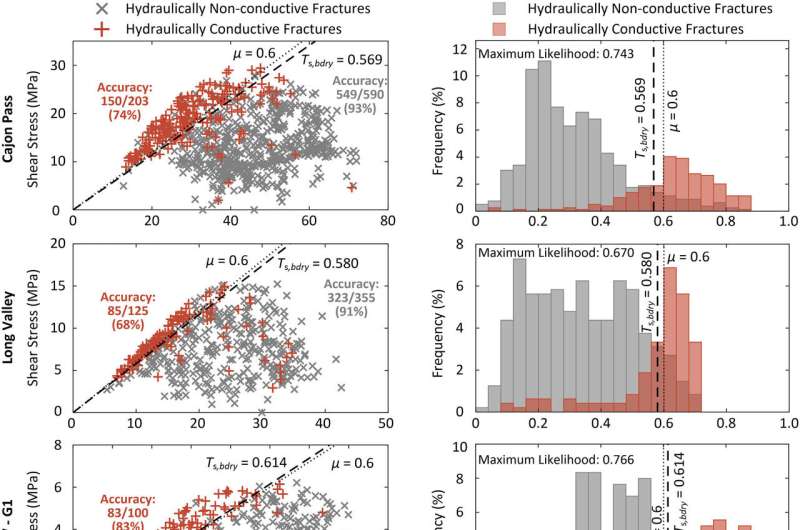Earth’s crustal stress can be inferred from fluid flow of fractures in deep boreholes
by KeAi Communications Co.
To gain a deeper understanding of a wide range of geological processes, such as plate tectonics, earthquakes and volcanic diking, we need to have a knowledge of both past and present in situ stress field. In particular, information on crustal in situ stress at various spatial and temporal scales is crucial in dealing with issues such as oil and gas extraction, geothermal development, carbon dioxide and nuclear waste disposal—all of which are practical problems in the subsurface.
However, the major limitation in addressing these problems lies in existing techniques, which are generally time-consuming and costly. Consequently, only a limited amount of stress data can be derived.
In a study recently published in Rock Mechanics Bulletin, scientists from University of Science and Technology of China (USTC) and Stanford University jointly proposed a novel method that infers crustal stress from fluid flow signatures of fractures in deep boreholes.
“We were initially inspired by the empirical correlation between the fracture fluid flow and its stress criticality—whether it tends to slip or not under the prevailing crustal stress state. This correlation was observed more than 20 years ago by Prof. Mark Zoback and his group at Stanford University,” explains Dr. Shihuai Zhang, lead investigator of the study at USTC.
“Deep into the crust, the fracture criticality and the stress state is difficult to determine. However, it is relatively easy to characterize whether a fracture allows fluid flow via borehole temperature logs; a measurable thermal anomaly near a fracture typically indicates fluid flow.”
The team applied binary classification—one of the simplest models in data science—to fracture fluid flow signatures. Abundant fractures of various orientations identified from four deep scientific boreholes enable an inversion of the crustal stress state, which strives to best match fractures showing fluid flow with critically stressed ones, and vice versa.
“The stress state efficiently determined using this approach is practically the same as that determined by conventional methods,” shares Prof. Xiaodong Ma, corresponding author of this study.
“This novel method depends only on image logs and temperature logs. Hence, it is easy to conduct and can be widely applied in deep boreholes. Convenient data acquisition may potentially enable data-oriented interpretation on the interconnectedness between fractures, fluid flow and crustal stress in the big data era.”
More information:
Shihuai Zhang et al, Determination of the crustal friction and state of stress in deep boreholes using hydrologic indicators, Rock Mechanics Bulletin (2022). DOI: 10.1016/j.rockmb.2022.100024
Provided by
KeAi Communications Co.
Citation:
Earth’s crustal stress can be inferred from fluid flow of fractures in deep boreholes (2023, March 21)
retrieved 21 March 2023
from https://phys.org/news/2023-03-earth-crustal-stress-inferred-fluid.html
This document is subject to copyright. Apart from any fair dealing for the purpose of private study or research, no
part may be reproduced without the written permission. The content is provided for information purposes only.
by KeAi Communications Co.

To gain a deeper understanding of a wide range of geological processes, such as plate tectonics, earthquakes and volcanic diking, we need to have a knowledge of both past and present in situ stress field. In particular, information on crustal in situ stress at various spatial and temporal scales is crucial in dealing with issues such as oil and gas extraction, geothermal development, carbon dioxide and nuclear waste disposal—all of which are practical problems in the subsurface.
However, the major limitation in addressing these problems lies in existing techniques, which are generally time-consuming and costly. Consequently, only a limited amount of stress data can be derived.
In a study recently published in Rock Mechanics Bulletin, scientists from University of Science and Technology of China (USTC) and Stanford University jointly proposed a novel method that infers crustal stress from fluid flow signatures of fractures in deep boreholes.
“We were initially inspired by the empirical correlation between the fracture fluid flow and its stress criticality—whether it tends to slip or not under the prevailing crustal stress state. This correlation was observed more than 20 years ago by Prof. Mark Zoback and his group at Stanford University,” explains Dr. Shihuai Zhang, lead investigator of the study at USTC.
“Deep into the crust, the fracture criticality and the stress state is difficult to determine. However, it is relatively easy to characterize whether a fracture allows fluid flow via borehole temperature logs; a measurable thermal anomaly near a fracture typically indicates fluid flow.”
The team applied binary classification—one of the simplest models in data science—to fracture fluid flow signatures. Abundant fractures of various orientations identified from four deep scientific boreholes enable an inversion of the crustal stress state, which strives to best match fractures showing fluid flow with critically stressed ones, and vice versa.
“The stress state efficiently determined using this approach is practically the same as that determined by conventional methods,” shares Prof. Xiaodong Ma, corresponding author of this study.
“This novel method depends only on image logs and temperature logs. Hence, it is easy to conduct and can be widely applied in deep boreholes. Convenient data acquisition may potentially enable data-oriented interpretation on the interconnectedness between fractures, fluid flow and crustal stress in the big data era.”
More information:
Shihuai Zhang et al, Determination of the crustal friction and state of stress in deep boreholes using hydrologic indicators, Rock Mechanics Bulletin (2022). DOI: 10.1016/j.rockmb.2022.100024
Provided by
KeAi Communications Co.
Citation:
Earth’s crustal stress can be inferred from fluid flow of fractures in deep boreholes (2023, March 21)
retrieved 21 March 2023
from https://phys.org/news/2023-03-earth-crustal-stress-inferred-fluid.html
This document is subject to copyright. Apart from any fair dealing for the purpose of private study or research, no
part may be reproduced without the written permission. The content is provided for information purposes only.
